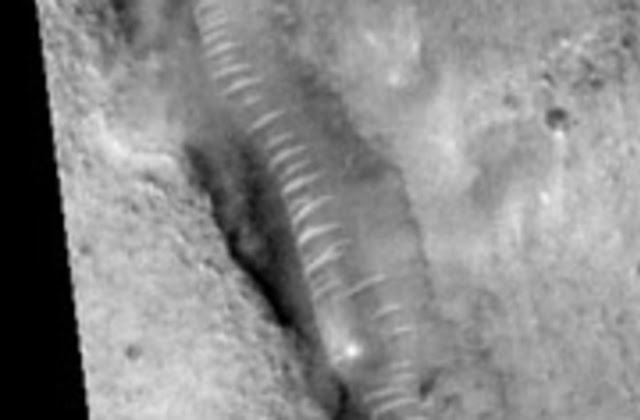 |
| Fig.
1: An alleged photo of a sandworm briefly surfacing, captured by the
Curiosity rover. In reality it is a rock formation of crystals whose
surrounding matrix has eroded away. |
The majority of life on Mars is tiny to microscopic in size. The number of lifeforms than can grow taller than a human can be counted on one hand. Any megafauna has been extinct for millennia, if not for millions or even billions of years. Or has it?
Rumours abound of the great dustbowl desert of the northern hemisphere being home to a gigantic creature that swims through the sands like a whale through water. These rumours of “sandworms” are largely based on grainy satellite imagery, geological structures claimed to be “worm-signs”, including the infamous canals, and some eyewitness-reports made by space tourists. At least one Mongolian cosmonaut claims to have seen one as well, likening it to the “olgoi-khorkoi” of his homeland. Professional spacefarers of western countries have meanwhile never made such claims (though even if they did see one, they might not report it out of fear of being seen as unprofessional, as often happens with UFOs). Nobody has ever been able to produce any physical evidence or even clear photographs of the creature.
There are various reasons that speak against the creature’s biological reality. For one, it seems physically impossible for an organism to move through sand as if it were water, especially at the claimed great speeds. Sand simply does not work that way and even if it did, the friction would create an unimaginable amount of abrasion and heat that would likely damage most organisms. At least one cryptoxenologist, Roy Sanderson, has countered this by claiming that the worm might be able to create vibrations in the ground that turn sand into a non-newtonian fluid that makes it easier to swim through. If this really were the case though, seismometers at various Martian research stations would have surely picked up evidence of such vibrations.
Even ignoring that, there is the question of how an organism this big would even be able to subsist in a biome with so little plant and animal life. Some cryptoxenologists have argued that in the deep underground of Mars there might be hidden lush ecosystems that the worms might be feeding on, like sperm-whales diving into the abyss to catch squids before surfacing. There is no evidence for these hidden ecosystems, so this is just special pleading. A more sensible suggestion that has been made is that the sandworms might be lithotrophs, literally feeding on the iron dust they plough though, because we actually know these types of organisms exist on Mars. This has led to some fanciful speculations that the worms might be giant offshoots of the otherwise small dust slugs. The problem is that the iron-reducing lithotrophy of the dust slugs is an inefficient energy-source that seems very unlikely to be capable of supporting any larger animal. Though we do not know how this system changes if an organism with a larger gut is able to ingest far greater amounts at a faster rate. Similarly to hindgut-fermentation in sauropod dinosaurs, larger body sizes might actually make digestion far more efficient than in smaller animals. But this is just speculation with no direct evidence.
Lastly, even if it is on another planet, it seems highly unlikely that an organism this large would go undetected for so long. Even if they lived 99% of their lives underground, the movements these creatures would create would, as mentioned, surely be detectable by seismometers.
 |
| Fig. 2: Satellite imagery claimed by Holland to show a giant worm or wormsign. |
But if these sandworms are mere myths, then why do people keep claiming to have seen them? Perhaps the very first claims of giant sandworms on Mars, certainly the first ones to be widely published, were made by one William T. Holland in December 1978, based on grainy satellite imagery he claimed to show the worms and traces left behind by them. The images in reality just showed dune-filled canyons, which appeared convex instead of concave due to lighting. However, the date of Holland’s claims is highly intriguing, as they were made just a few months after the release of part 1 of Alejandro Jodorowsky’s epic Dune quadrilogy. Just like the novel they were based on, the movies prominently displayed the fictional giant sandworms of Arrakis, brought to life thanks to H.R. Giger’s amazing designs and Phil Tippet’s ground-breaking go-motion technology. It seems very likely that Holland’s interpretation of the images were coloured by the movies and their popularity among general audiences further boosted the perceived plausibility of the cryptid. Many of the space-tourists who claimed that the unusual sand dunes they saw crawl across the desert were the legendary worms admitted to having read Holland’s books on the matter, so their interpretation was thus indirectly also coloured by Jodorowsky’s Dune. Therefore, they all saw giant sandworms on Mars because they wanted to see them.


Yay, worldbuilding! Even xenobiology has its cranks, it seems
ReplyDelete